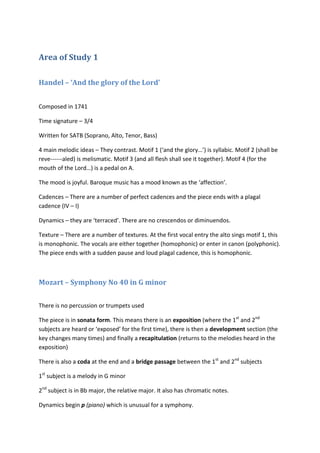Revision Area of Study 1
- 1. Area of Study 1 Handel ŌĆō ŌĆśAnd the glory of the LordŌĆÖ Composed in 1741 Time signature ŌĆō 3/4 Written for SATB (Soprano, Alto, Tenor, Bass) 4 main melodic ideas ŌĆō They contrast. Motif 1 (ŌĆśand the gloryŌĆ”ŌĆÖ) is syllabic. Motif 2 (shall be reve------aled) is melismatic. Motif 3 (and all flesh shall see it together). Motif 4 (for the mouth of the LordŌĆ”) is a pedal on A. The mood is joyful. Baroque music has a mood known as the ŌĆśaffectionŌĆÖ. Cadences ŌĆō There are a number of perfect cadences and the piece ends with a plagal cadence (IV ŌĆō I) Dynamics ŌĆō they are ŌĆśterracedŌĆÖ. There are no crescendos or diminuendos. Texture ŌĆō There are a number of textures. At the first vocal entry the alto sings motif 1, this is monophonic. The vocals are either together (homophonic) or enter in canon (polyphonic). The piece ends with a sudden pause and loud plagal cadence, this is homophonic. Mozart ŌĆō Symphony No 40 in G minor There is no percussion or trumpets used The piece is in sonata form. This means there is an exposition (where the 1st and 2nd subjects are heard or ŌĆśexposedŌĆÖ for the first time), there is then a development section (the key changes many times) and finally a recapitulation (returns to the melodies heard in the exposition) There is also a coda at the end and a bridge passage between the 1st and 2nd subjects 1st subject is a melody in G minor 2nd subject is in Bb major, the relative major. It also has chromatic notes. Dynamics begin p (piano) which is unusual for a symphony.
- 2. The time signature is 4/4. There are lots of perfect cadences. The ending alternates between chords I and V. Textures ŌĆō Homophonic (particularly at the end) and polyphonic. Chopin ŌĆō Prelude no. 15 in Db major Tonality - Db major for the A section, C# minor for the B section. The harmony is diatonic (meaning ŌĆō belongs to the key) Structure ŌĆō ABA Coda, ternary with short coda or codetta. Romantic era.Composed in 1838. Keyboard techniques ŌĆō expressive. Melodies are played cantabile (ŌĆśin the singing styleŌĆÖ). Use of pedals. The piece is played rubato(ŌĆśrobbed timeŌĆÖ ŌĆō ebb and flow to the music). Section B ŌĆō key change to C# minor (tonic minor). The right hand plays the ŌĆśraindropŌĆÖ note, or pedal, which becomes G# instead of Ab (also enharmonically the same note). Section B the music becomes louder. This section is longer than section A. Melody is played by the left hand.


